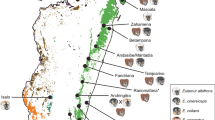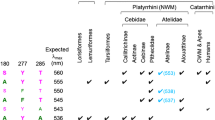Abstract
The intensity of available light is important in determining how well a diurnal animal can distinguish color. Primates with different types of color vision may exhibit behaviors that maximize visual contrast during critical activities such as feeding. We hypothesized that (1) trichromatic taxa will feed in a wide range of light conditions because color constancy permits stabilized color appearance across changes in illumination, and (2) that taxa with a high proportion of dichromatic individuals will tend to feed at higher light levels to increase color contrast. We recorded light levels during feeding bouts of seven primate taxa with varying degrees of color vision: the dichromatic Lemur catta, two polymorphic species, Propithecus v. verreauxi and Ateles geoffroyi, and the routine trichromats, Alouatta palliata, Colobus guereza, Piliocolobus badius, and Cercopithecus ascanius. Results were equivocal for our hypotheses. While routinely trichromatic taxa used varying light levels, the pattern of results did not differ from the dichromatic Lemur catta. However, polymorphic taxa not only sought the highest light, but females, which are the only individuals in polymorphic taxa that can be trichromatic, fed in higher light levels than males when eating non-green foods. This result is consistent with selection operating to maintain a balanced polymorphism in these taxa, though the connection between light levels and color vision type for the females is unclear. Our results further suggest that trichromatic vision may afford a selective advantage because it permits foraging under a greater range of light levels.







Similar content being viewed by others
References
Altmann J (1974) Observational study of behavior: sampling methods. Behaviour 69:227–267
Arrese CA, Hart NS, Thomas N, Beazley LD, Shand J (2002) Trichromacy in Australian marsupials. Curr Biol 12:657–660
Brill MH (1990) Mesopic color matching: some theoretical issues. J Opt Soc Am A 7:2048–2051
Campbell JL, Eisemann JH, Williams CV, Glenn KM (2000) Description of the gastrointestinal tract of five lemur species: Propithecus tattersalli, Propithecus verreauxi coquereli, Varecia variegata, Hapalemur griseus, and Lemur catta. Am J Primatol 52:133–142
Cant JGH (1977) Ecology, locomotion and social organization of spider monkeys (Ateles geoffroyi). PhD Thesis, University of California
Chapman CA (1987) Flexibility in diets of three species of Costa Rican primates. Folia Primatol 49:90–105
Chapman CA, Chapman LJ, Rode KD, Hauck EM, McDowell LR (2003) Variation in the nutritional value of primate foods: among trees, time periods, and areas. Int J Primatol 24:317–333
Craig CL, Weber RS, Bernard GD (1996) Evolution of predator-prey systems: spider foraging plasticity in response to the visual ecology of prey. Am Nat 147:205–229
Curtis DJ, Zaramody A, Martin RD (1999) Cathemerality in the mongoose lemur, Eulemur mongoz. Am J Primatol 47:279–298
Dominy NJ, Lucas PW (2001) Ecological importance of trichromatic vision to primates. Nature 410:363–366
Dominy NJ, Lucas PW (2004) Significance of color, calories, and climate to the visual ecology of catarrhines. Am J Primatol 62:189–207
Dominy NJ, Garber PA, Bicca-Marques JC, De O. Azevedo-Lopes MA (2003a) Do female tamarins use visual cues to detect fruit rewards more successfully than do males? Anim Behav 66:829–837
Dominy NJ, Lucas PW, Wright SJ (2003b) Mechanics and chemistry of rain forest leaves: canopy and understorey compared. J Exp Biol 54:2007–2014
Donati G, Lunardini A, Kappeler PM, Borgognini Tarli SM (2001) Nocturnal activity in the cathemeral red-fronted lemur (Eulemur fulvus rufus), with observations during a lunar eclipse. Am J Primatol 53:69–78
Endler JA (1990) On the measurement and classification of color in studies of animal color patterns. Biol J Linn Soc 41:315–352
Endler JA (1991) Variation in the appearance of guppy color patterns to guppies and their predators under different visual conditions. Vision Res 31:587–608
Endler JA (1993) The color of light in forests and its implications. Ecol Monogr 63:1–27
Endler JA (1997) Light, behavior, and conservation of forest-dwelling organisms. In: Clemmons JR, Buchholz R (eds) Behavioral approaches to conservation in the wild. Cambridge University Press, Cambridge, pp 329–355
Endler JA, Thery M (1996) Interacting effects of lek placement, display behavior, ambient light, and color patterns in three neotropical forest-dwelling birds. Am Nat 148:421–452
Erkert HG (1989) Lighting requirements of nocturnal primates in captivity: a chronobiological approach. Zoo Biol 8:179–191
Erkert HG, Kappeler PM (2004) Arrived in the light: diel and seasonal activity patterns in wild Verreaux’s sifakas (Propithecus v. verreauxi; Primates: Indriidae). Behav Ecol Sociobiol 57:174–186
Estrada A (1984) Resource use by howler monkeys (Alouatta palliata) in the rain forest of Los Tuxtlas, Veracruz, Mexico. Int J Primatol 51:105–131
Fernandez-Duque E (2003) Influences of moonlight, ambient temperature, and food availability on the diurnal and nocturnal activity of owl monkeys (Aotus azarai). Behav Ecol Sociobiol 54:431–440
Glander KE (1975) Habitat description and resource utilization: a preliminary report on mantled howling monkey ecology. In: Tuttle RH (ed) Socioecology and psychology of primates. Mouton, The Hague, pp 37–57
Gomez D, Thery M (2004) Influence of ambient light on the evolution of colour signals: comparative analysis of a Neotropical rainforest bird community. Ecol Lett 7:279–284
Hartshorn GS (1983) Plants: introduction. In: Janzen DH (ed) Costa Rican natural history. University of Chicago Press, Chicago, Ill., pp 118–157
Hemingway CA (1998) Selectivity and variability in the diet of Milne-Edwards’ sifakas (Propithecus diadema edwardsi): implications for folivory and seed-eating. Int J Primatol 19:355–377
Holdridge LR (1967) Life zone ecology. Tropical Science Center, San José, Costa Rica
Jacobs GH (1993) The distribution and nature of colour vision among the mammals. Biol Rev 68:413–471
Jacobs GH (1995) Variations in primate color vision: mechanisms and utility. Evol Anthropol 3:196–205
Jacobs GH, Deegan JF II (2003) Diurnality and cone photopigment polymorphism in strepsirrhines: examination of linkage in Lemur catta. Am J Phys Anthropol 122:66–72
Jacobs GH, Neitz M, Deegan JF II, Neitz J (1996) Trichromatic colour vision in New World monkeys. Nature 382:156–158
Jacobs GH, Deegan JF II, Tan Y, Li W-H (2002) Opsin gene and photopigment polymorphism in a prosimian primate. Vision Res 42:11–18
Kappeler PM, Erkert HG (2003) On the move around the clock: correlates and determinants of cathemeral activity in wild redfronted lemurs (Eulemur fulvus rufus). Behav Ecol Sociobiol 54:359–369
Kavanau JL, Peters CR (1976) Twilight Zeitgebers, weather, and activity of nocturnal primates. Folia Primatol 26:67–79
Kelber A, Vorobyev M, Osorio D (2003) Animal colour vision—behavioural tests and physiological concepts. Biol Rev 78:81–118
Leal M, Fleishman LJ (2004) Differences in visual signal design and detectability between allopatric populations of Anolis lizards. Am Nat 163:26–39
Lucas PW, Darvell BW, Lee PKD, Yuen TDB, Choong MF (1998) Colour cues for leaf food selection by long-tailed macaques (Macaca fascicularis) with a new suggestion for the evolution of trichromatic colour vision. Folia Primatol 69:139–152
Lucas PW, Dominy NJ, Riba-Hernández P, Stoner KE, Yamashita N, Loría-Calderón E, Petersen-Pereira W, Rojas-Durán Y, Salas-Pena R, Solis-Madrigal S, Osorio D, Darvell BW (2003) Evolution and function of routine trichromatic vision in primates. Evolution 57:2636–2643
Milton K (1980) The foraging strategy of howler monkeys: a study in primate economics. Columbia University Press, New York
National Resource Council (1981) Techniques for the study of primate population ecology. National Academy Press, Washington, D.C.
Overdorff DJ (1988) Preliminary report on the activity cycle and diet of the red-bellied lemur (Lemur rubriventer) in Madagascar. Am J Primatol 16:143–153
Pariente G (1974) Influence of light on the activity rhythms of two Malagasy lemurs: Phaner furcifer and Lepilemur mustelinus leucopus. In: Martin RD, Doyle GA, Walker AC (eds) Prosimian behaviour. Duckworth, London, pp 183–198
Pereira ME, Strohecker RA, Cavigelli SA, Hughes CL, Pearson DD (1999) Metabolic strategy and social behavior in Lemuridae. In: Rakotosamimanana B, Rasamimanana H, Ganzhorn JU, Goodman SM (eds) New directions in lemur studies. Kluwer/Plenum, New York, pp 93–118
Regan BC, Julliot C, Simmen B, Viénot F, Charles-Dominiques P, Mollon JD (1998) Frugivory and colour vision in Alouatta seniculus, a trichromatic platyrrhine monkey. Vision Res 38:3321–3327
Riba-Hernández P (2004) Efecto de la vista a color polimórfica y los carbohidratos solubles en la selección de frutos por el mono araña (Ateles geoffroyi). Master’s Thesis, University of Costa Rica
Riba-Hernández P, Stoner KE, Osorio D (2004) Effect of polymorphic colour vision for fruit detection in the spider monkey (Ateles geoffroyi) and its implications for the maintenance of polymorphic colour vision in platyrrhine monkeys. J Exp Biol 207:2465–2470
Richard AF, Dewar RE (1991) Lemur ecology. Ann Rev Ecol Syst 22:145–175
Sauther ML, Sussman RW, Gould L (1999) The socioecology of the ringtailed lemur: thirty-five years of research. Evol Anthropol 8:120–132
Schaefer HM, Schmidt V, Wesenberg J (2002) Vertical stratification and caloric content of the standing fruit crop in a tropical lowland forest. Biotropica 34:244–253
Schneider N, von Campenhausen C (1998) Color and lightness constancy in different perceptual tasks. Biol Cybern 79:445–455
Shyue S-K, Hewett-Emmett D, Sperling H, Hunt D, Bowmaker J, Mollon JD, Li W-H (1995) Adaptive evolution of color vision genes in higher primates. Science 269:1265–1267
Smith AC, Buchanan-Smith HM, Surridge AK, Mundy NI (2003a) Leaders of progressions in wild mixed-species troops of saddleback (Saguinus fuscicollis) and mustached tamarins (S. mystax), with emphasis on color vision and sex. Am J Primatol 61:145–157
Smith AC, Buchanan-Smith HM, Surridge AK, Osorio D, Mundy NI (2003b) The effect of colour vision status on the detection and selection of fruits by tamarins (Saguinus spp.). J Exp Biol 206:3159–3165
Stoner KE (1996) Habitat preferences and seasonal patterns of activity and foraging in two troops of mantled howling monkeys (Alouatta palliata) in a rainforest in northeastern Costa Rica. Int J Primatol 17:1–30
Struhsaker TT (1997) Ecology of an African rainforest: logging in Kibale and the conflict between conservation and exploitation. University of Florida Press, Gainesville, Fla.
Suchi S, Rothe H (1999) The influence of abiotic factors on the onset and cessation of activity of semi-free Callithrix jacchus. Am J Primatol 47:241–253
Sumner P, Mollon JD (2000) Catarrhine photopigments are optimized for detecting targets against a foliage background. J Exp Biol 203:1963–1986
Surridge AK, Osorio D, Mundy NI (2003) Evolution and selection of trichromatic vision in primates. Trends Ecol Evol 18:198–205
Tan Y, Li W-H (1999) Trichromatic vision in prosimians. Nature 402:36
Vorobyev M, Osorio D (1998) Receptor noise as a determinant of colour thresholds. Proc R Soc Lond B 265:351–358
Wright PC (1999) Lemur traits and Madagascar ecology: coping with an island environment. Yearb Phys Anthropol 42:31–72
Yamashita N (1996) Seasonality and site-specificity of mechanical dietary patterns in two Malagasy lemur families (Lemuridae and Indriidae). Int J Primatol 17:355–387
Acknowledgements
This study was funded by grants from the Royal Grants Council, Croucher Foundation, and National Geographic Society to P.W.L. We would like to thank P.Y. Cheng for his logistical expertise during all phases of this project. This research could not have been carried out without the cooperation of organizations in the host countries where it was conducted: in Madagascar, the Association Nationale pour la Gestation des Aires Protégées; the Departement des Eaux et Fôret; the Université d’Antananarivo; the staff at the Madagascar Institut pour la Conservation des Environnements Tropicaux; Joel Ratsirarson and the staff at Beza Mahafaly for all their assistance and kindness; and Alison Richard and Bob Sussman for censussing the lemurs at Beza Mahafaly. In Costa Rica we are grateful to the Guanacaste Conservation Area for logistics and permits to work at the Murciélago ranger station. In Uganda, we thank the late Patrick Kagoro, Boniface Balyeganira and Moses Musana, our field assistants, and also Colin Chapman, Joanna Lambert and Richard Wrangham for their help. Research was made possible by the Ugandan National Council for Science and Technology, Ugandan Wildlife Authority and Makerere University Biological Field Station (director, J. Kasenene). We also thank D. Osorio for comments on an earlier draft of this manuscript. The comments of three anonymous reviewers aided the clarity of the manuscript considerably.
Author information
Authors and Affiliations
Corresponding author
Additional information
Communicated by P. Kappeler
Rights and permissions
About this article
Cite this article
Yamashita, N., Stoner, K.E., Riba-Hernández, P. et al. Light levels used during feeding by primate species with different color vision phenotypes. Behav Ecol Sociobiol 58, 618–629 (2005). https://doi.org/10.1007/s00265-005-0936-4
Received:
Revised:
Accepted:
Published:
Issue Date:
DOI: https://doi.org/10.1007/s00265-005-0936-4




